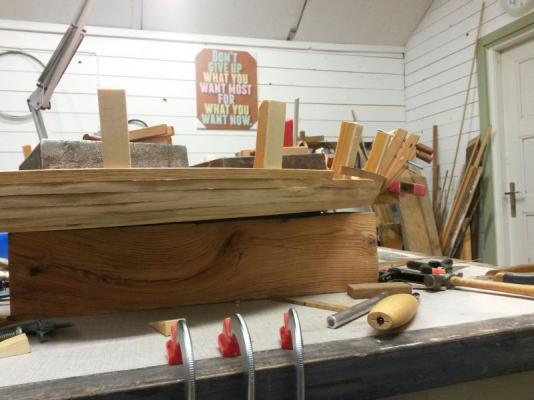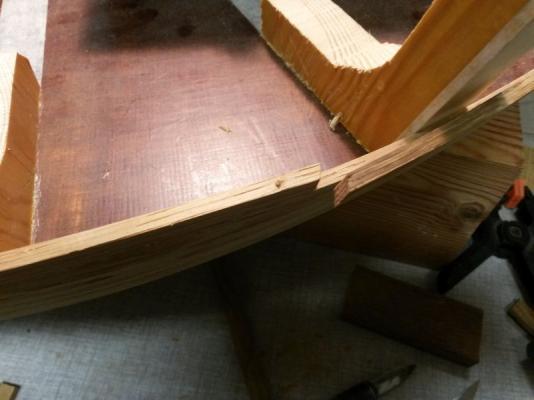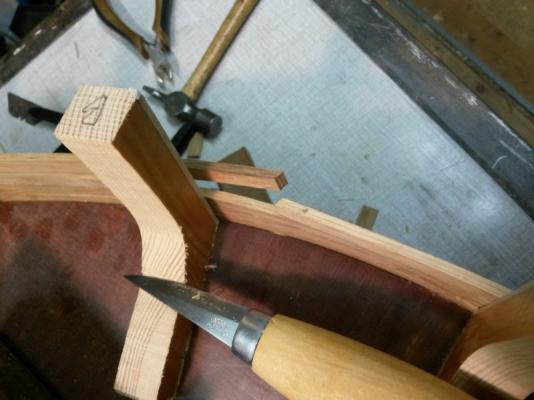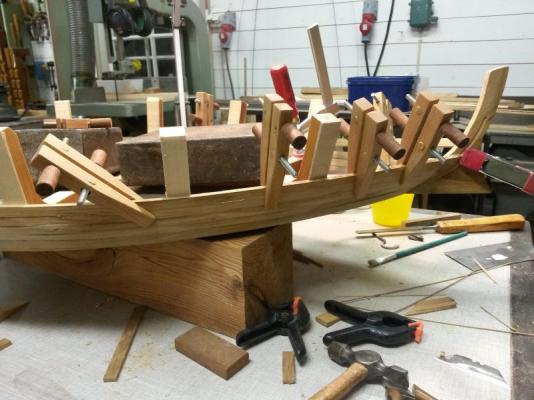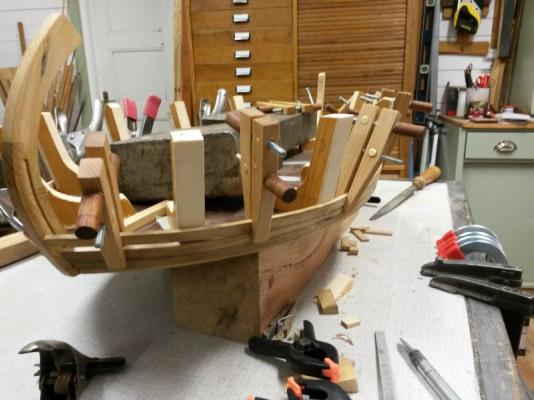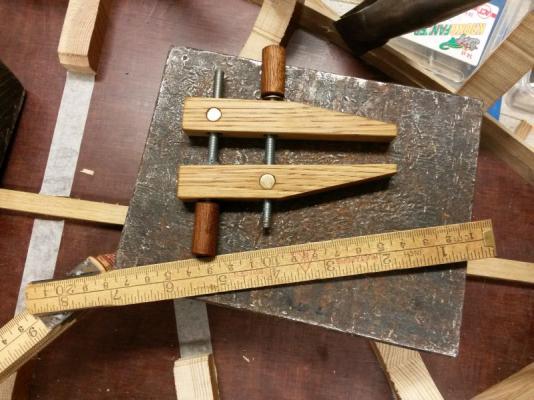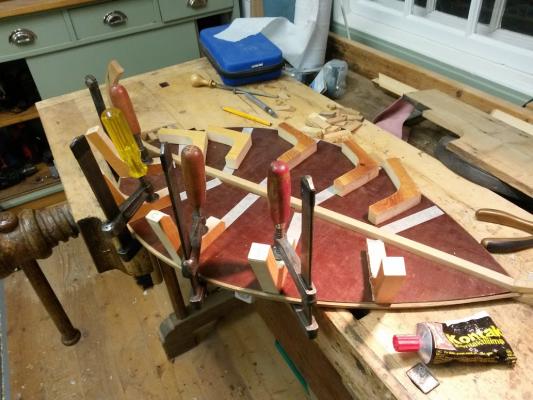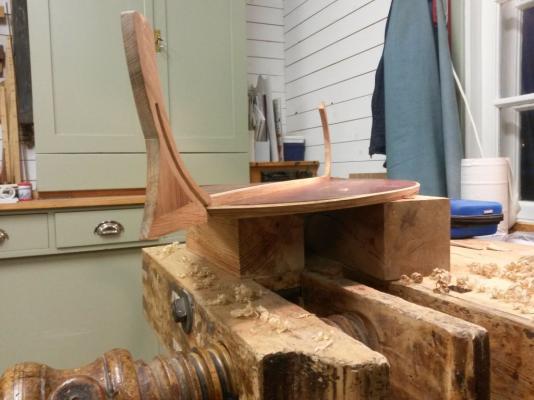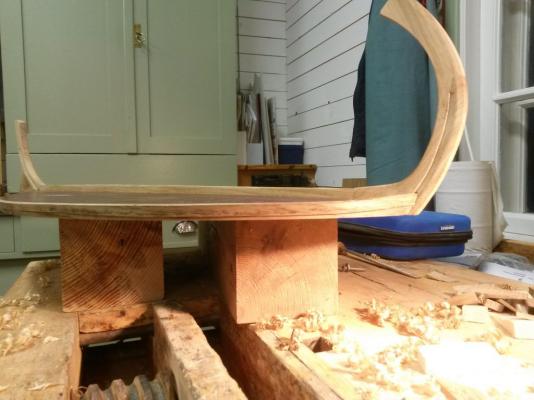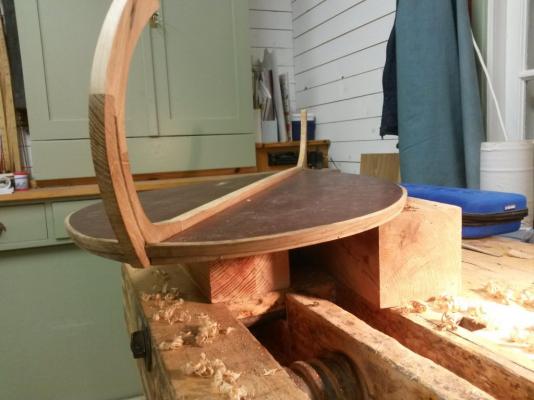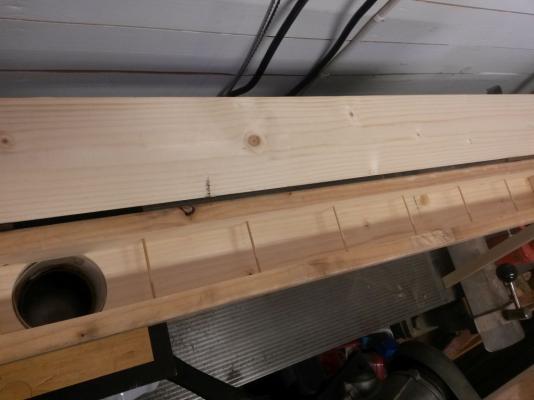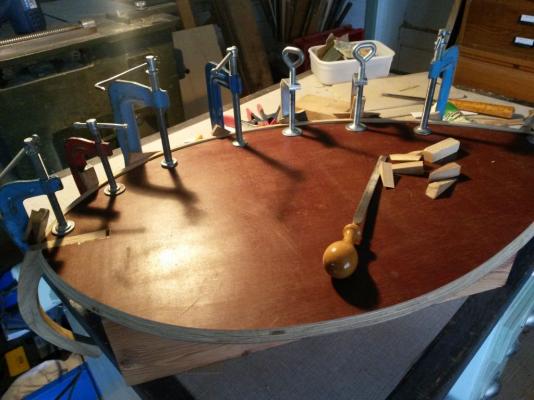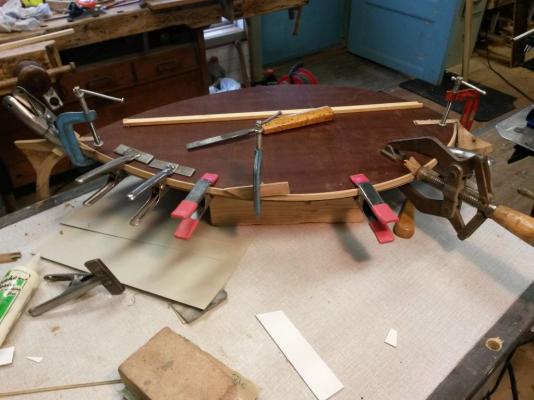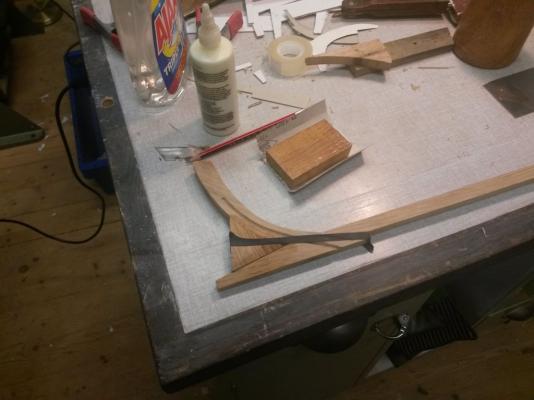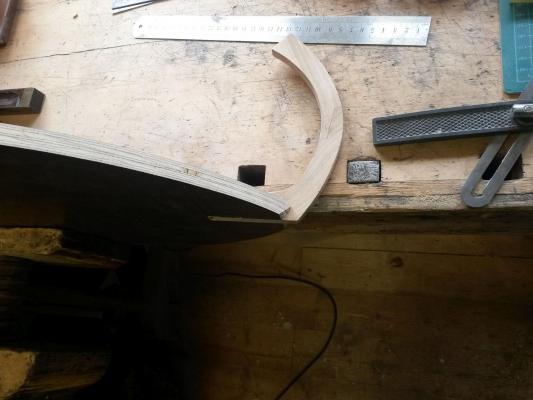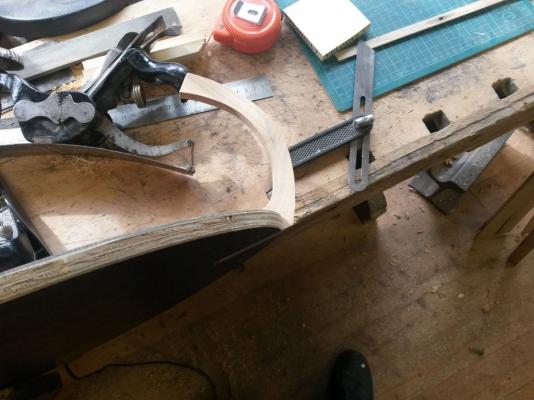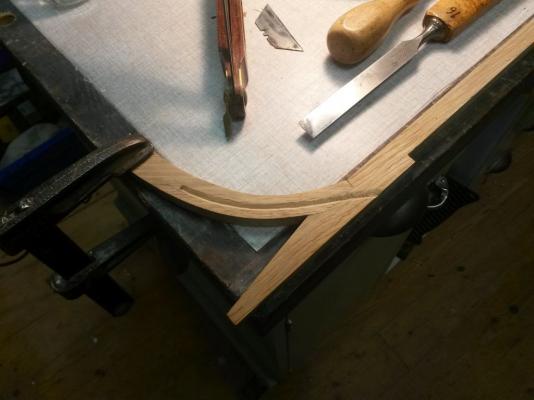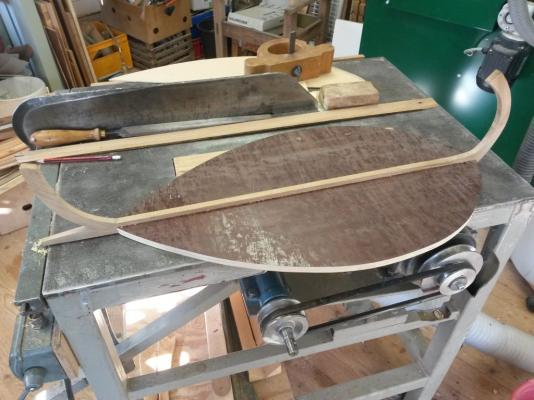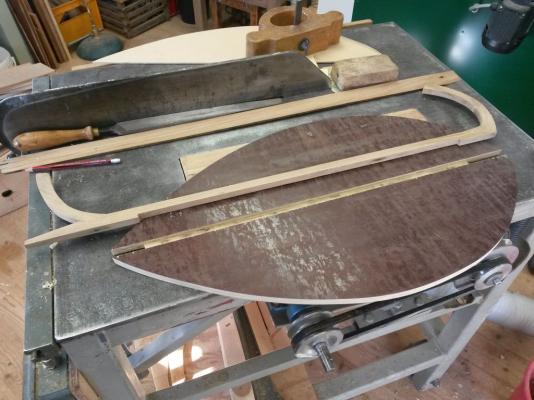-
Posts
993 -
Joined
-
Last visited
Content Type
Profiles
Forums
Gallery
Events
Everything posted by Wintergreen
-
Its such a pretty little ship, John. Hope you are well.
- 745 replies
-
- francis pritt
- mission ship
-
(and 1 more)
Tagged with:
-
Thank you fellows for likes and comments. Ed, the clamps work really well with good power. Cred to you for initially posting about tool making in your Naiad log. The steambox, however crude in appearance, works really well. I have it on the floor so I dont have to bother about the condensation dripping allover. The rubber bands keep the lid tight to the box so the steam only can escape through the 10mm hole in the far side. The oak planks get so soft so that I have to watch out for them not bending too tight round the uprights. Which can be spotted in some of the pics... The kettle takes 3 liters while I usually only fill it to half in order to save boiling time. Thanks for asking, Ed. Michael, no worries. Its just a straight forward box that anyone would've come up with. A down-scaled version of the real deal.
-
Michael, you started just before Xmas with drafting and now you are onto laying the deck? Don't you have anything better to do? Just kidding! Please keep on your delightful building. One note on the mast hoops, when I saw that you used the gummed paper I thought it to be a slightly bad idea since the gum softens with water and this would be a pond model...but so a simple error would you not let yourself to I saw reading on. Excellent build.
-
Another update. Not that I've been busy as a bee, but things are nevertheless progressing. (it can also be the fact that our pastor asked about it the other day...) The first strakes I put in, without scarfs. Really tedious and hard to get proper alignment and nice joints to stem and stern. So, to ease my burden I changed the habit and cut the planks in two. The joint is a simple box joint, slightly angled. I will not put a covering piece on the inside, instead there are pins drilled through the topmost plank , into the underlying plank. This is also done at stem and stern. The aftermost plank goes on first and the pin at the rear helps keeping the plank in place longitudinally. While the furthermost plank gets the pin in place prior to gluing to aid in proper fitting in the box joint. A really sharp carpenters knife is useful to work away the waste. Apart from that, ordinary files are used and a little no 12 Stanley low angle block plane to work on the plank height (or width, whatever you want to call it). Also notable in the pictures are my very untidy workplace. As can be seen in the pictures is the crude hull shape. Lots of dents and gaps and so. But since the plank thickness is 4 mm there is no real danger for me to be able to sand through the sides. As for the gaps, I will try wood filler of the sort that cabinet makers use. Here is the sequence. Plank bent to shape... ...and fitted to stem. The open joint where the rear plank is glued and pinned in place. at another angle and the tool. Held and glued in place And finally the clamps gone, Alas this is of course the other side. Clamps at the rear are holding next two planks in place so we are really picking up pace here... About the sign on the wall in the first picture...did I mention that I bought a blue ocean sailing yacht, late august? Didn't I? But I DID! A long long dream come true and I am so so happy!
-
Ed, I'm not online here very often, but every time I do login, I turn to your log for inspiration and to keep the interest re ship modelling fed properly. Sincere thanks for your splendid work and presentation. The flywheels are just stunning.
- 3,618 replies
-
- young america
- clipper
-
(and 1 more)
Tagged with:
-
Ah, I see. Thanks. So its basically a long drop on deck. But a dozen men on a boat of 15m? And she seems fully loaded as well, sitting low in the water.
- 745 replies
-
- francis pritt
- mission ship
-
(and 1 more)
Tagged with:
-
"Dunny" John? Nice progress and up to your usual standard as well.
- 745 replies
-
- francis pritt
- mission ship
-
(and 1 more)
Tagged with:
-
Hopefully the updates will come a bit more frequent from now on. As previously noted, an awful autumn, but recovering is steady. Yay. Strake no 3 in place and 4 on the go. Did one of those silly mistakes again. Cut a plank a couple of mms too short...gah! Good practice to fit new ones though... And before you ask, a close up of the new homemade clamps. When comparing to Eds original I realize I some day might want longer rods to widen the gap. Well, they were quite easy to put together so over time they might get siblings.
-
Inspirational progress Ed! I can really image one or two thoughts passing through before you put the saw to the bulwarks...but as always, excellent execution.
- 3,618 replies
-
- young america
- clipper
-
(and 1 more)
Tagged with:
-
So, finally I figured it out...it took me only, what? 6 months on how to proceed... No, not really. Day-job, you know, and the dreaded wall of fatigue was close up front. Didnt bang into it though, for which I'm glad. Anyway, two strakes on, how to get the rest on without bulkheads. Some simple and crude frames might be the solution. The masking tape is to get the positioning of frame pairs equal. Contact cement between the tape and the frame will make for a desent bond I hope. And not to cumbersome to peel off when I get to that.
-
Hi Carl, sorry for my absence...work took the better part of my life during spring so no time in the shop at all. Not even time to live, wich is sad. However, I have been compensated The boat sits nicely on my carpenters bench, waiting, probably as you do too...any day (week, month) now, I will get back to it.
-
So, first 2 + 2 strakes on. Not without a struggle though. And as they say on the tube "mind the gap" Nothing a good sanding and filler wont hide so I am happy for the time being. Next up I need to make some dummy frames to clamp to the floor board. Otherwise I guess I will be in too much trouble fitting planks. Speaking of which, the steam chest worked like a charm. I know from reading that oak bends really well when steamed, but it was still fun to see with my own eyes. From a couple of different angles, here is the evidence.
-
So, was a bit creative the last day...bought a stove good for 2,5 hp (funny, you never relate to electric equipment that generates heat in horsepower...always the dull kW...) "My heatgun can blast at 2 hp!" Nope, you never hear that. Anyway, a couple of pictures. The construction was straight forward. No glue, just stainless steel patio screws. The lid was firstly put on to tight so I had to rearrange the hinges at add a sealing profile. Drilled a 10 mm hole in the far end of the lid also to let the steam out. The box is 90 cm long, inside height 45 mm and inside width ca 55 mm. And the inside. Planks rests on elevated bamboo skewers. Finally, take two on the first plank. In a gleaming "time to lock up and go inside" kind of light.
-
Thanks for the "Likes" and tips, mates. I have a heat gun, but I guess I was a little to eager because it didnt soften the oak. Or so I thought. Since I am planning on actually do more scale ship modelling I will invest time in a proper setup for a steambox. Shouldnt be too complicated I think. And of course I could just drop the planks in hot water. But then again, safety of handling hot water and so.. Oak, yes, Mario, why take the easy path down life???
-
Question for the weekend: How do you plank a boat that lacks frames? And subsequent, do I really need to go down the spiling path? It took the entire Saturday to come up with the answer which is kind of: Nah, you dont really... Next question, how do you soak a plank that is nearly 1m long? The obvious answer to that is: In something that is just above 1m long and holds water... Went all over my place to find something useful. The closest I got was A. the bathtub on 2nd floor. B. Flower tray (unfortunately pierced to drain water...) Think again. Eventually I used some leftover gutters from my renovations. Wacked it to the shape of an ugly tray and voilá! There it was. Have only knocked it over once up to now. The shop floor needed some soaking anyway....not! Back to planking. First I ripped down the plank to some 8mm width. Then it went for a bath. Unsuccessful tries were performed yesterday so I gave up and left it in water for the time being. Went back to the shipyard this morning with a fresh set of mind (well, almost fresh). Having spent the last 12 hrs in water the oak was mildly negotiable both laterally and longitudinally. It will be a struggle nevertheless. Summary: I need more C-clamps.
-
Was able to sneak some time in the shop tonight. All four rabbets are cut. Not to Remcos standard, but well, very few can reach his standard... I had previously cut and shaped the cutwater piece so I glued it in place now. The black rubber band is a scrapped bicycle tube cut at an angle. Very handy to have. For the bigger bands needed I snip from the 2" one, and for smaller I use a scrapped road tube, ca 1" in dia. When the glue has dried I will shape the entire stem to get rid of the bulky appearance that is has now.
-
Hi Alan, welcome to my place. Any questions, just ask. Great building table you put to together. Todays update re the build. First out was to plane a bevel on the floor. Started by setting the for and aft bevels inline with the stem and stern lines. After that I continued the bevel from fore to amidships and from aft to amidships to minimize tear-out. Regarding using cutting handtools, it is an absolute joy to work with very sharp tools. How come you ask? Well, work had me on watch over the Xmas holidays which generated some extra to the budget so I ordered a long sought after addition to my shop, the Tormek sharpening system. I ordered the larger one and I have not regretted it. It IS pricey, yes, but then I do a lot more than just scratch wood for models. Also, in the pictures I try to let the tools I use linger around in the pictures so that viewers can see what has been used for each step. Stem bevel. And stern And here the entire line is cut. After the bevel was in place I started the rabbet. This was my first go at a rabbet, but I am fairly pleased with the outcome. Planks are 4 mm thick which I hope makes for a quite easy plank-rabbet mating process later.
-
No worries Mario, you are helping very much. Thanks for the link, I've been to that site a couple of times. My scale is somewhat floating, but nevertheless I want it to be reasonable when it comes to dimensions. As can be seen in the latest images the hull is way wider than the original. (So much for scale) But that has to do with this models purpose, being a candle holder of sort. Ben, you are welcome. There is plenty of space on the first row
-
Back from abroad and able to spend some quality time in the shop ... yay. One thing that struck me today is that some day..any day ... in the future .. I will actually put together some accurate plans and then think through a step by step scheme to work by. However, this is not that day. I am more like Jack Sparrow (Captain Jack Sparrow) making it up as I go kind of type. Since the hull will be semi filled with sand I reckoned it needed a form stable flooring. In my stash I found an old piece of plywood of unknown origin (not really, I know exactly where it came from) some 12 mm thick. Next problem to solve was whether I should make two half sides and attach to the "keel" in some ingenious way. I opted out for that and instead made single piece floor. Problem with that was how to attach the backbone to it. Instead of more words, the pictures will tell the answer. First with the backbone in place And then to show the solution. Next up will be to bevel the plywood and also cut a rabbet in the stem and stern. Mario, a question to you if you read this, Do you have any information on the dimension of the planks for the hull? The thickness I have worked out, but how broad were they? Do you know? The scale I am building to is somewhere in the range of 1/12 - 1/15.
-
Thanks Mario, re "correct as possible" this time it will be a bit different I am planning to ease my pain a bit by not making it a replica or true scale model. Hope you dont get too disappointed friend. At this point I have no more progress to show, working on ripping planks for flooring and sides. Lots of uninteresting sawdust, but I will take some progress shots nevertheless. Tomorrow current projects at work has send me to London for the week...one of those weeks you know. My workshop will miss me and I it.
About us
Modelshipworld - Advancing Ship Modeling through Research
SSL Secured
Your security is important for us so this Website is SSL-Secured
NRG Mailing Address
Nautical Research Guild
237 South Lincoln Street
Westmont IL, 60559-1917
Model Ship World ® and the MSW logo are Registered Trademarks, and belong to the Nautical Research Guild (United States Patent and Trademark Office: No. 6,929,264 & No. 6,929,274, registered Dec. 20, 2022)
Helpful Links
About the NRG
If you enjoy building ship models that are historically accurate as well as beautiful, then The Nautical Research Guild (NRG) is just right for you.
The Guild is a non-profit educational organization whose mission is to “Advance Ship Modeling Through Research”. We provide support to our members in their efforts to raise the quality of their model ships.
The Nautical Research Guild has published our world-renowned quarterly magazine, The Nautical Research Journal, since 1955. The pages of the Journal are full of articles by accomplished ship modelers who show you how they create those exquisite details on their models, and by maritime historians who show you the correct details to build. The Journal is available in both print and digital editions. Go to the NRG web site (www.thenrg.org) to download a complimentary digital copy of the Journal. The NRG also publishes plan sets, books and compilations of back issues of the Journal and the former Ships in Scale and Model Ship Builder magazines.




